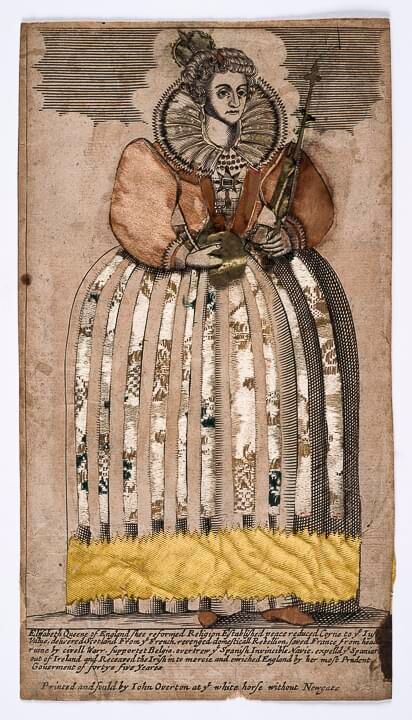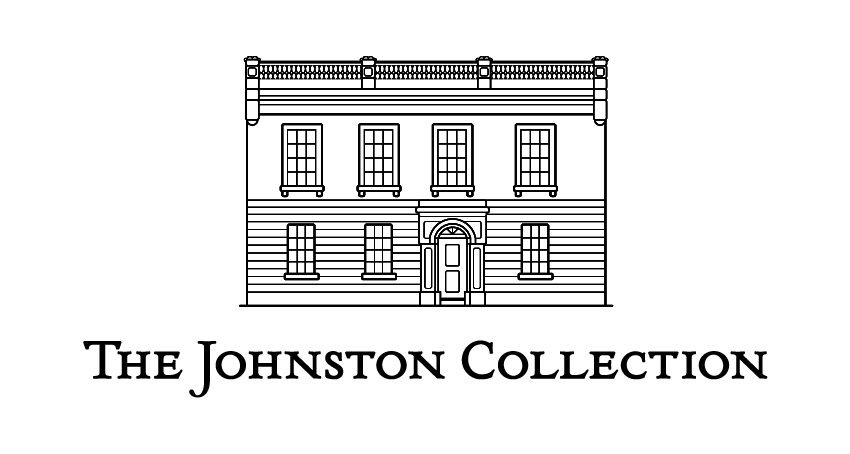The Queene’s New Clothes: An Adorned print of Elizabeth I

The Queene’s New Clothes: An Adorned print of Elizabeth I
By Dr Louise Voll Box
This image of Elizabeth I, Queen of England and Ireland (1533-1603) is an intriguing example of print culture, and a rare survivor. This work brings together ideas related to the production, consumption, and dissemination of prints, and the eighteenth-century pastime of cutting and pasting prints into new creative forms.
The print that is the basis of this work was originally printed en masse for a popular market. A later, unknown hand has skilfully trimmed and removed sections of the print to transform this ‘multiple’ into a unique artwork. Luxurious textiles have been adhered to the verso, the effect augmented by metallic trim. These embellishments, now visible through the cut-away sections of the printed paper, create an enhanced image of the monarch. Prints such as these, decorated with textiles, are variously described by scholars as adorned prints, decorated prints, or dressed plates.
The print’s lettering suggests it was printed and sold by successful printer/publisher John Overton (1639/40-1713) at ‘Ye White Horse without Newgate’, London. Although Overton operated from this address from 1668-1707, the design was probably created earlier, as in 1665, Overton purchased the stock of another successful printseller / publisher Peter Stent (active circa 1642-1665), who had also operated at ‘Ye White Horse’.[i] ‘Elizabeth’ is visually aligned with Stent’s prints of English royalty and the aristocracy published in the middle 1600s, so it is possible the plate was acquired from Stent and then re-issued with Overton’s name.[ii] Duplication and re-use of texts and images was common in the print trade at this time.
The embellishment of prints with textiles can be located within the European fashion for manipulating prints and paper that peaked in the eighteenth century, when the adept performance of print cutting and pasting became a marker of elite sociability and taste.[iii] Some of these activities — undertaken by men and women — include cutting paper into decorative shapes (such as intricate paper foliage cut by Mary Delany (1700-1788)); glass transfer painting (using prints as templates for painting on glass); découpage and japanning (varnishing prints onto furniture or fans); and the adhering of prints onto domestic interior walls (‘print rooms’).
These fashionable, print-related entertainments were noted in magazines and advertisements. Overton’s 1672 catalogue publicised prints with designs useful for ‘all handicrafts’.[iv] In the 1720s, Mercure de France noted the fashion for découpage and featured advertisements for decorative print designs. English publishers targeted the growing market for paper-based crafts with advertisements for prints ‘useful to the Ladies’ including those suitable for japanning.[v]
Prints depicting fashionable women in elaborate gowns (‘fashion prints’) were particularly popular, early eighteenth-century subjects for cutting and adornment with fine silks, laces, and gilt details.[vi] Contemporary textiles — including off-cuts from a new garment or furnishings — were used as print decoration, but prints adorned in this way may have already been several decades old. Dating the textile embellishments on ‘Elizabeth’ is challenging without undertaking scientific analysis of the fibres and dyes.
Not everyone was convinced about the fashion for print and paper cutting. Writers expressed concern that the print collections of connoisseurs would be at risk from eager découpeurs seeking new prints ‘with scissors in hand’.[vii] English poet and satirist Alexander Pope (1688-1744) criticised the craze’s frivolity in his poem, On the Countess of Burlington Cutting Paper: ‘See, madam, see the arts o’erthrown / Between John Overton and you!’.
Despite their popularity, adorned prints are now relatively rare survivors, especially those dating from the 1600s. The decorative nature of adorned prints meant they were often displayed in domestic settings, rather than stored with other prints in albums or portfolios. As a result, adorned prints have been especially susceptible to light and insect damage, and to changing tastes. Today, only a few examples are extant in collections such as the British Museum, the Bibliothèque nationale de France, The Morgan Library and Museum (New York), and the V&A, although occasionally, some tired specimens can still be seen gracing the walls of country houses.
The many facets of ‘Elizabeth Queene of England’ make it a fascinating and important addition to The Johnston Collection.
DR LOUISE VOLL BOX
DR LOUISE VOLL BOX is CEO of The Johnston Collection. Her research interests include 18th-century material culture, the English Country House, print collecting and display, and business and the arts.
Image: printed by John Overton (English, 1639/1640-1713), untitled (Elizabeth Queene of England), London, circa 1668-1707, print on paper, silk fabric, thread, metal | 300 x 170 mm, The Johnston Collection, bequest of C H (Roger) Brookes, Melbourne, 2021 (A1895).
Journals
About US
Explore
Contact
VISIT
See our VISIT page for hours and directions
BY PHONE
+61 3 9416 2515
BY POST
PO Box 79, East Melbourne VIC 8002
ONLINE
General enquiries
Membership enquiries
Shop
Donation enquiries
Subscribe to E-Newsletter



